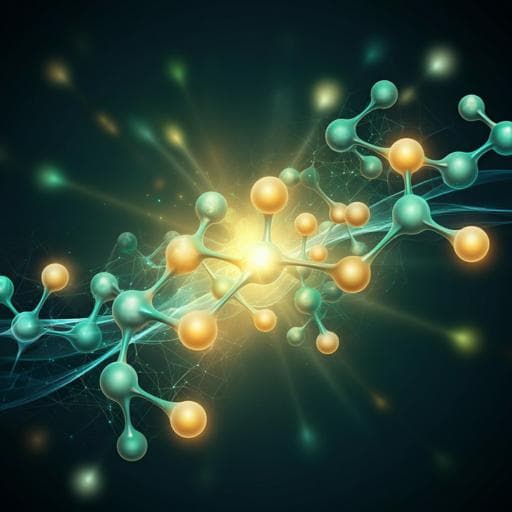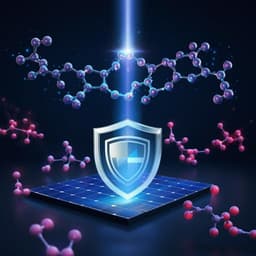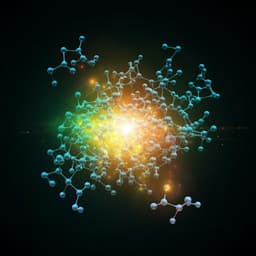
Engineering and Technology
Rational molecular and device design enables organic solar cells approaching 20% efficiency
J. Fu, Q. Yang, et al.
Discover how the innovative design of the non-fullerene acceptor o-BTP-eC9 leads to a significant power conversion efficiency of 19.9%, as presented by a team of researchers including Jiehao Fu, Qianguang Yang, and many more. This advancement not only reduces energy loss but also enhances operational stability in organic solar cells.
~3 min • Beginner • English
Introduction
The rapid development in light-harvesting materials, especially non-fullerene acceptors (NFAs), has driven major progress in organic solar cells (OSCs). To further improve competitiveness and commercial viability, devices must achieve higher power conversion efficiency (PCE) and stability. Improving efficiency requires increasing open-circuit voltage (VOC) and maintaining efficient exciton dissociation and charge transport, i.e., simultaneously suppressing energy loss (Eloss = Eg − eVOC) and realizing ideal nano-scale morphology. Minimizing VOC loss demands suppression of charge transfer (CT) state absorption and improvement of electroluminescence quantum efficiency (EQEEL), but rational molecular design to meet these aims remains challenging. Additionally, Eloss depends not only on the intrinsic donor/acceptor properties but also on nano-morphology (distribution, aggregation, packing), hence surface energy and crystallinity must be considered in molecular design. Introducing a suitable third component into high-performance binary NFA blends is a common strategy to enhance device efficiency without disturbing favorable host morphology; NFAs with tailored halogen substitution positions can preserve molecular orientation and miscibility while tuning aggregation and photoelectronic properties. Guided by theoretical calculations, the authors design an isomeric acceptor, o-BTP-eC9, by changing the chlorine substitution on the dichlorinated IC-2Cl end groups of BTP-eC9, aiming to tune LUMO level, dielectric constant, and crystallinity to reduce Eloss and optimize blend morphology.
Literature Review
Prior studies established NFAs as key to high-efficiency OSCs and highlighted the role of reducing voltage losses (CT absorption and non-radiative recombination) and enhancing EQEEL. Work on ternary OSCs showed a third component can synergistically improve morphology, reduce recombination, and increase FF and PCE. Halogen substitution positions on end groups significantly affect intermolecular interactions, stacking, and device performance. The intensity borrowing mechanism suggests uplifting the acceptor LUMO reduces VOC loss. Previous reports achieved >18–19% PCE via morphology refinement (double-fibril networks) and reduced non-radiative losses. Models of ternary OSCs emphasize compatibility and miscibility between acceptors to form a well-mixed phase and hierarchical morphology. This study builds on these insights by isomer engineering of the IC-2Cl end group to tune dipole moment, LUMO level, dielectric constant, and crystallinity while maintaining miscibility with a benchmark acceptor.
Methodology
Design and theory: Quantum chemistry calculations were performed to assess six IC-2Cl end-group isomers (α-o-IC-2Cl, β-o-IC-2Cl, o-o-IC-2Cl, α-m-IC-2Cl, β-m-IC-2Cl, p-IC-2Cl), evaluating dipole moments and frontier orbital levels. The o-o-IC-2Cl showed the lowest dipole moment (3.22 D) and highest LUMO (−3.70 eV), guiding selection for o-BTP-eC9. DFT simulations (BLYP/6-31G) computed electrostatic potential surfaces and corroborated a higher LUMO for o-BTP-eC9.
Synthesis and characterization: o-BTP-eC9 was synthesized via routes in Supplementary Figs. 2–3. Structures were confirmed by 1H/13C NMR, GC-MS, MALDI-TOF MS, and single-crystal X-ray analysis. The modified o-o-IC-2Cl end group afforded higher yields than β-o-IC-2Cl (end-group yield 54% vs 36%; condensation yield 96% vs 53%).
Optoelectronic properties: UV–vis spectra were recorded in solution and films; dielectric constants (εr) were measured using capacitor devices; cyclic voltammetry (CV) determined HOMO/LUMO levels; ECT was obtained by fitting EQE/EL spectra with a probability distribution method.
Morphology and structure: GIWAXS and GISAXS characterized molecular orientation, π–π stacking, lamellar peaks, and crystalline region sizes; AFM (tapping mode) probed surface topography and phase separation; contact-angle measurements (water/glycerol) yielded surface energies via Wu’s model, and Flory–Huggins interaction parameters χ estimated miscibility.
Device fabrication: Conventional structure ITO/PEDOT:PSS/active layer/PFN-Br/Ag. ITO substrates were cleaned and UV–ozone treated; PEDOT:PSS spin-coated and annealed. Active-layer precursor solutions: 7.3 mg PM6 donor, 8.7 mg acceptor(s), and 12.5 mg 1,4-diiodobenzene (DIB) additive in 1 mL chloroform, heated to 60 °C for 1 h then cooled; optimized ternary used BTP-eC9:o-BTP-eC9 weight ratio 1.05:0.15; active layer thickness ~120 nm; thermal annealing at 100 °C for 5 min. PFN-Br (~5 nm, 0.5 mg/mL in methanol) was coated; 100 nm Ag evaporated (active area 11 mm²).
Device testing: J–V measured with Keithley 2400 and AAA solar simulator (AM 1.5G, 1000 W/m²) using a metal mask, forward scan −0.2 to 1.2 V. EQE with Enlitech QE-R. Certified PCE via asymptotic Pmax scan at an ISO/IEC 17025 accredited lab (Enli Tech). Stability under 1-sun MPP tracking reported as T80. EQEEL and highly sensitive EQE were measured with PECT-600/ELCT-3010 systems.
Charge transport and recombination: Space-charge-limited current (SCLC) devices measured hole/electron mobilities. Transient photocurrent (TPC, short-circuit) and transient photovoltage (TPV, open-circuit) yielded decay times (τ) for extraction and recombination. VOC vs light intensity evaluated trap-assisted recombination (slope n·kT/q). Photocurrent Jph vs effective voltage Veff determined charge collection probability Pcoll.
Key Findings
- Theoretical screening identified o-o-IC-2Cl as an optimal end group, enabling o-BTP-eC9 with a higher LUMO and suitable dipole moment compared to BTP-eC9.
- Optical/electronic properties (Table 1): o-BTP-eC9 vs BTP-eC9: LUMO −3.86 eV vs −3.92 eV; HOMO −5.70 eV vs −5.71 eV; Eg 1.84 eV vs 1.79 eV; film λmax 825.6 nm vs 828.2 nm; ECT 1.40 eV vs 1.37 eV. Film red-shift smaller for o-BTP-eC9 (79 nm vs 81 nm), indicating weaker π–π stacking.
- Dielectric constant: εr = 2.9 (o-BTP-eC9) vs 2.4 (BTP-eC9), implying reduced exciton binding energy with o-BTP-eC9.
- Crystallinity and orientation: Both acceptors show face-on orientation with π–π (010) peaks at q ≈ 1.68 Å−1. o-BTP-eC9 has smaller crystallite coherence lengths (CCL010 15.3 Å; CCL100 57.1 Å) than BTP-eC9 (CCL010 18.2 Å; CCL100 59.5 Å), indicating weaker crystallinity.
- Miscibility: Surface energies γ (mN·m−1): PM6 20.71, BTP-eC9 24.94, o-BTP-eC9 25.57. Flory–Huggins χ parameters: χPM6:BTP-eC9 = 0.196K; χPM6:o-BTP-eC9 = 0.256K; χBTP-eC9:o-BTP-eC9 = 0.0039K, showing excellent miscibility between the two acceptors and a tendency for clearer phase separation in PM6:o-BTP-eC9.
- Binary device performance (Table 2):
• PM6:BTP-eC9: VOC 0.843 V; JSC 28.27 mA cm−2 (EQE-integrated 27.39); FF 79.17%; PCE 18.87% (avg 18.63 ± 0.11%).
• PM6:o-BTP-eC9: VOC 0.901 V; JSC 26.33 mA cm−2 (25.54); FF 78.83%; PCE 18.71% (avg 18.50 ± 0.11%).
- Ternary (PM6:o-BTP-eC9:BTP-eC9, 0.15:1.05 wt of acceptors): VOC 0.860 V; JSC 28.75 mA cm−2 (27.83); FF 80.41%; champion PCE 19.88% (avg 19.55 ± 0.15%); certified 19.48% by asymptotic Pmax scan.
- Energy loss analysis (Table 3): Eg (eV) PM6:BTP-eC9 1.396, PM6:o-BTP-eC9 1.413, Ternary 1.397; Eloss (eV) 0.541, 0.500, 0.525, respectively. ΔE2 reduced from 0.069 eV (BTP) to 0.048 eV (o-BTP), attributed to higher ECT and higher εr. EQEEL increased from 4.0×10−2 (BTP) to 7.0×10−2 (o-BTP) and 6.6×10−2 (ternary), yielding low ΔE3 of 0.188–0.190 eV (vs 0.202 eV for BTP), among the lowest for >18% PCE OSCs.
- Charge transport/dynamics: μh ≈ 4×10−4 cm2 V−1 s−1 for all; μe: 5.1×10−4 (BTP) vs 3.5×10−4 (o-BTP); ternary μh = 3.8×10−4, μe = 4.0×10−4 with more balanced transport. TPC τ: ternary 0.66 µs (fastest extraction). TPV τ: ternary 1.97 µs (least recombination). VOC–Plight slope n lower for ternary (1.02), indicating suppressed trap-assisted recombination. Pcoll at short-circuit: ternary 99.2%.
- Morphology: AFM Rq decreased from 0.99 nm (BTP) to 0.70 nm (ternary); phase cluster size reduced from 18.1 nm (BTP) to 15.7 nm (ternary). GIWAXS shows similar π–π distance (~3.7 Å) but smaller CCL010 in o-BTP and intermediate in ternary. GISAXS crystalline region sizes: 21 nm (BTP), 12 nm (o-BTP), 18 nm (ternary), evidencing moderated crystallization.
- Stability: Under 1-sun MPP stress, T80: ternary 724 h vs PM6:BTP-eC9 428 h and PM6:o-BTP-eC9 578 h.
Discussion
Engineering the chlorination position on the IC-2Cl end group of a benchmark acceptor enables simultaneous tuning of key molecular parameters: a higher LUMO level, increased dielectric constant, and reduced crystallinity in o-BTP-eC9. These changes uplift the CT-state energy and decrease both radiative (ΔE2) and non-radiative (ΔE3) voltage losses, thereby increasing VOC while maintaining high FF. Although o-BTP-eC9 narrows absorption and reduces JSC in the binary blend compared to BTP-eC9, its excellent miscibility and complementary crystallinity with BTP-eC9 allow it to function effectively as a guest acceptor in a ternary system. The ternary blend refines phase separation, balances charge transport, suppresses trap-assisted recombination, and enhances charge collection, leading to simultaneous improvements in VOC, JSC, and FF. Consequently, record single-junction PCEs near 20% with reduced energy losses and enhanced operational stability are achieved. These results demonstrate a rational molecule-to-device design pathway, where subtle isomeric modifications of end-group halogen positions can systematically optimize energetics and morphology to overcome traditional trade-offs in OSCs.
Conclusion
Guided by DFT, the authors designed and synthesized o-BTP-eC9 by altering the chlorination position in IC-2Cl end groups, yielding a non-fullerene acceptor with a shallower LUMO, higher dielectric constant, and weaker crystallinity than BTP-eC9. In PM6:o-BTP-eC9 devices, the uplifted CT state reduces both radiative and non-radiative recombination losses, delivering high VOC and 18.7% PCE. Leveraging the excellent miscibility and complementary crystallinity/energetics between o-BTP-eC9 and BTP-eC9, a ternary PM6:BTP-eC9:o-BTP-eC9 blend achieves 19.9% PCE (19.5% certified) with improved charge balance, morphology, and stability. This rational molecular and device design approach provides an effective avenue for developing new NFA guest molecules toward high-performance, stable OSCs. Future work can extend isomeric end-group engineering to other acceptor families to further reduce energy losses and approach theoretical efficiency limits.
Limitations
In binary PM6:o-BTP-eC9 devices, the narrower absorption range of o-BTP-eC9 leads to a lower JSC relative to PM6:BTP-eC9. The reduced crystallinity of o-BTP-eC9 also yields slower electron mobility than BTP-eC9, though this is mitigated in the ternary blend by more balanced charge transport.
Related Publications
Explore these studies to deepen your understanding of the subject.







